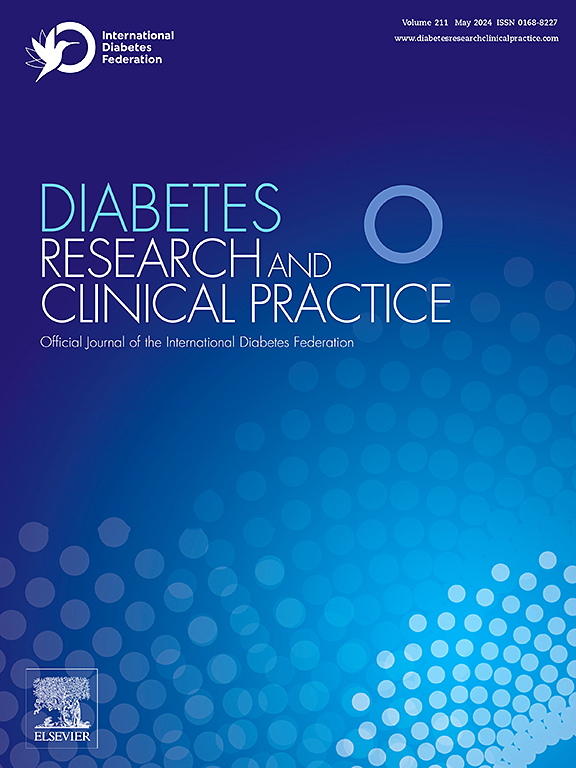老年2型糖尿病患者开始使用钠-葡萄糖共转运蛋白-2抑制剂与二肽基肽酶-4抑制剂后痴呆的风险:160,752例患者的5年回顾性队列分析
IF 6.1
3区 医学
Q1 ENDOCRINOLOGY & METABOLISM
引用次数: 0
摘要
目的:与二肽基肽酶-4抑制剂(DPP4i)相比,本研究探讨了钠-葡萄糖共转运蛋白-2抑制剂(SGLT2i)在降低老年2型糖尿病(T2DM)患者痴呆风险中的神经保护作用。方法使用TriNetX电子健康记录网络,我们对2013年1月1日至2024年11月30日期间接受SGLT2i或DPP4i治疗的≥65岁T2DM患者进行了回顾性队列研究。采用倾向评分匹配来创建两个平衡的队列,主要结局是新发痴呆。次要结果包括与痴呆症相关的药物使用和痴呆症亚型,如阿尔茨海默病和血管性痴呆。结果经倾向评分匹配后,两组共纳入80376例患者。与DPP4i相比,使用SGLT2i与发生痴呆的风险显著降低相关(风险比[HR], 0.54;95%置信区间[CI]: 0.51-0.57;p & lt;0.001)。与痴呆相关的药物使用也有类似的减少(HR, 0.69;95% ci: 0.64-0.74;p & lt;0.001),阿尔茨海默病(HR, 0.53;95% ci: 0.48-0.60;p & lt;0.001),血管性痴呆(HR, 0.52;95% ci: 0.46-0.58;p & lt;0.001)。亚组分析显示出一致的保护作用。结论:与DPP-4i相比,使用SGLT2i与老年T2DM患者痴呆风险降低相关,在不同人群和患者亚组中观察到一致的益处。这些发现强调了SGLT2i作为认知能力下降的预防策略的潜力,并支持在随机对照试验中进一步研究。本文章由计算机程序翻译,如有差异,请以英文原文为准。
Risk of dementia after initiation of sodium-glucose cotransporter-2 inhibitors versus dipeptidyl peptidase-4 inhibitors in older adults with type 2 diabetes: A five-year retrospective cohort analysis of 160,752 patients
Objectives
This study investigated the neuroprotective effects of sodium-glucose cotransporter-2 inhibitor (SGLT2i) in reducing dementia risk among older adults with type 2 diabetes mellitus (T2DM), compared to dipeptidyl peptidase-4 inhibitors (DPP4i).
Methods
Using the TriNetX electronic health records network, we conducted a retrospective cohort study including adults aged ≥65 years with T2DM who initiated SGLT2i or DPP4i between January 1, 2013, and November 30, 2024. Propensity score matching was employed to create two balanced cohorts, with the primary outcome being new-onset dementia. Secondary outcomes included dementia-related drug use and subtypes of dementia, such as Alzheimer’s disease and vascular dementia.
Results
After propensity score matching, 80,376 patients were included in each group. SGLT2i use was associated with a significantly lower risk of developing dementia compared to DPP4i (hazard ratio [HR], 0.54; 95 % confidence interval [CI]: 0.51–0.57; p < 0.001). Similar reductions were observed for dementia-related drug use (HR, 0.69; 95 % CI: 0.64–0.74; p < 0.001), Alzheimer’s disease (HR, 0.53; 95 % CI: 0.48–0.60; p < 0.001), and vascular dementia (HR, 0.52; 95 % CI: 0.46–0.58; p < 0.001). Subgroup analyses showed consistent protective effects.
Conclusion
Compared to DPP-4i, SGLT2i use is associated with a lower risk of dementia in older adults with T2DM, with consistent benefits observed across diverse populations and patient subgroups. These findings highlight the potential of SGLT2i as a preventive strategy for cognitive decline and support further investigation in randomized controlled trials.
求助全文
通过发布文献求助,成功后即可免费获取论文全文。
去求助
来源期刊

Diabetes research and clinical practice
医学-内分泌学与代谢
CiteScore
10.30
自引率
3.90%
发文量
862
审稿时长
32 days
期刊介绍:
Diabetes Research and Clinical Practice is an international journal for health-care providers and clinically oriented researchers that publishes high-quality original research articles and expert reviews in diabetes and related areas. The role of the journal is to provide a venue for dissemination of knowledge and discussion of topics related to diabetes clinical research and patient care. Topics of focus include translational science, genetics, immunology, nutrition, psychosocial research, epidemiology, prevention, socio-economic research, complications, new treatments, technologies and therapy.
 求助内容:
求助内容: 应助结果提醒方式:
应助结果提醒方式:


